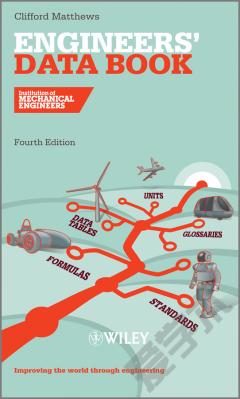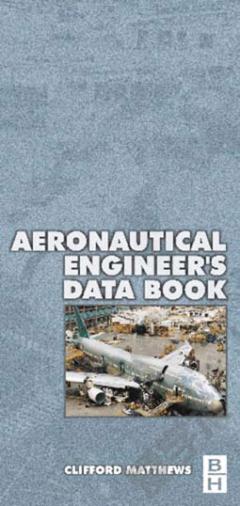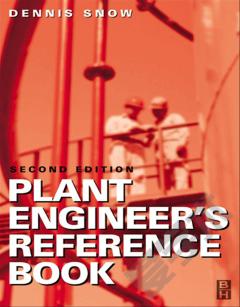Engineers' Data Book
Foreword - the Institution of Mechanical Engineers. Preface. Introduction - the Role of Technical Students. Web Sites: Quick References. Section 1:- Important Regulations and Directives. 1.1 The pressure equipment directive: SI 2001: 1999. 1.2 The pressure systems regulations: SI 128. 1.3 Health and Safety at work. 1.4 The European machinery directive. 1.5 Inspection terms and bodies: EN 45004: 1995. 1.6 UKAS accreditation marks. Section 2:- Units. 2.1 The Greek alphabet. 2.2 Units systems. 2.3 Units and conversions. 2.4 Consistency of units. 2.5 Dimensional analysis. 2.6 Essential engineering mathematics. Section 3:- Engineering Design - Process and Principles. 3.1 Engineering problem-solving. 3.2 Problem types and methodologies. 3.3 Design principles. 3.4 The engineering design process. 3.5 Design as a systematic activity (the 'Pugh' method). 3.6 The innovation model. 3.7 Creativity tools. 3.8 The product design specification (PDS). 3.9 Useful reference sources. Section 4:- Basic Mechanical Design. 4.1 Engineering abbreviations. 4.2 Datums and tolerances - principles. 4.3 Toleranced dimensions. 4.4 General tolerances. 4.5 Holes. 4.6 Screw threads. 4.7 Surface finish. Section 5:- Motion. 5.1 Making sense of equilibrium. 5.2 Motion equations. 5.3 Newton's laws of motion. 5.4 Simple harmonic motion (SHM). 5.5 Understanding acceleration. 5.6 Dynamic balancing. 5.7 Vibration. 5.8 Machine vibration. 5.9 Machinery noise. Section 6:- Deformable Body Mechanics. 6.1 Quick reference - mechanical notation. 6.2 Engineering structures - so where are all the pin joints?. 6.3 Simple areas and strain. 6.4 Simple elastic bending. 6.5 Slope and deflection of beams. 6.6 Torsion. 6.7 Thin cylinders. 6.8 Cylindrical vessels with hemispherical ends. 6.9 Thick cylinders. 6.10 Buckling of struts. 6.11 Flat circular plates. 6.12 Stress concentration factors. Section 7:- Material Failure. 7.1 How materials fail. 7.2 LEFM method. 7.3 Multi-axis stress states. 7.4 Fatigue. 7.5 Factors of safety. 7.6 United states practice. Section 8:- Thermodynamics and Cycles. 8.1 Quick reference: symbols - thermodynamics. 8.2 Basic thermodynamic laws. 8.3 Entropy. 8.4 Enthalpy. 8.5 Other definitions. 8.6 Cycles. 8.7 The steam cycle. 8.8 Properties of steam. 8.9 Reference information. 8.10 The gas turbine (GT) cycle. Section 9:- Basic Fluid Mechanics and Aerodynamics. 9.1 Basic properties. 9.2 Flow equations. 9.3 Flow regimes. 9.4 Boundary Layers. 9.5 Isentropic flow. 9.6 Compressible one-dimensional flow. 9.7 Normal shock waves. 9.8 Axisymmetric flows. 9.9 Drag coefficients. 9.10 General airfoil theory. 9.11 Airfoil coefficients. 9.12 Pressure distributions. 9.13 Aerodynamic centre. 9.14 Centre of pressure. 9.15 Supersonic conditions. 9.16 Wing loading: semi-ellipse assumption. Section 10:- Fluid Equipment. 10.1 Turbines. 10.2 Refrigeration systems. 10.3 Diesel engines. 10.4 Heat exchangers. 10.5 Centrifugal pumps. 10.6 Impeller types. Section 11:- Pressure Vessels. 11.1 Vessel codes and standards. 11.2 Pressure vessel design features. 11.3Cylindrical pressure vessel design stresses. 11.4 Stress categories. 11.5 Analysis of stress combinations. 11.6 Vessel certification. 11.7 Flanges. Section 12:- Materials. 12.1 Observing crystals: order and disorder. 12.2 Carbon steels. 12.3 Low-alloy steels. 12.4 Alloy steels. 12.5 Cast Iron (CI). 12.6 Stainless steels. 12.7 Non-ferrous alloys. 12.8 Nickel alloys. 12.9 Zinc alloys. 12.10 Cooper alloys. 12.11 Aluminium alloys. 12.12 Titanium alloys. 12.13 Engineering plastics. 12.14 Material traceability and documentation. 12.15 Corrosion. Section 13:- Machine Elements. 13.1 Screw fasteners. 13.2 Bearings. 13.3 Ball and roller bearings. 13.4 Bearing lifetime. 13.5 Coefficient of friction. 13.6 Gear trains. 13.7 Seals. 13.8 Shaft coupling. 13.9 Cam mechanisms. 13.10 Clutches. 13.11 Pulley mechanisms. 13.12 Drive types. 13.13 Wire ropes. 13.14 Springs. 13.15 Miscellaneous. Section 14:- Quality Assurance and Quality Control. 14.1 Quality assurance: ISO 9000: 2000. 14.2 Quality system certification. 14.3 The ISO 9000: 2000 standards. 14.4 Taguchi methods. 14.5 Statistical process control (SPC). 14.6 Normal distribution. 14.7 The binomial and Poisson distributions. 14.8 Reliability. 14.9 Improving design reliability: main principles. 14.10 'Design for reliability' - a new approach. Section 15:- Project Engineering. 15.1 Project planning. 15.2 Critical path analysis (CPA). 15.3 Planning with gantt charts. 15.4 Rapid protocopying. 15.5 Value analysis. Section 16:- Welding. 16.1 Welding processes. 16.2 Weld types and orientation. 16.3 Welding symbols. 16.4 Welding defects. 16.5 Welding documentation. Section 17:- Non-Distructive Testing (NDT). 17.1 Non-distructive testing acronyms. 17.2 Visual examination. 17.3 Dye penetrant (DP) testing. 17.4 Magnetic particle (MP) testing. 17.5 Ultrasonic testing (UT). 17.6 Radiographic testing (RT). Section 18:- Surface Protection. 18.1 Painting. 18.2 Galvanizing. 18.3 Chrome planting. 18.4 Rubber linnings. Section 19:- Metallurgical Terms. Section 20:- Engineering Information Sources. 20.1 Internet sites. 20.2 The engineering council. Section 21:- Useful Catalogues and Data Sources. 21.1 Useful catalogues and data sources. 21.2 Useful electronic databases. 21.3 Additional electronic databases.
{{comment.content}}








 京公网安备 11010802027623号
京公网安备 11010802027623号